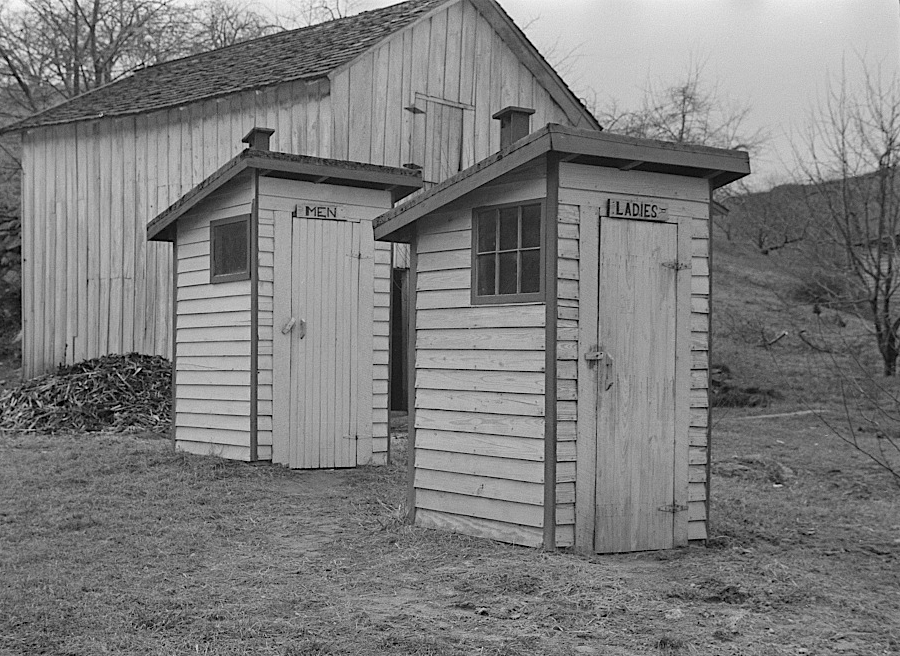
outhouses must be emptied - or moved when the hole in the ground is filled
Source: Library of Congress, Privies on road to Skyline Drive, Virginia (by Lee Russell, 1938)

outhouses must be emptied - or moved when the hole in the ground is filled
Source: Library of Congress, Privies on road to Skyline Drive, Virginia (by Lee Russell, 1938)
Sir John Harrington is often credited with creating the first flush toilet in 1592, for use by Queen Elizabeth I. However, archeologists have uncovered a 2,400-year-old lavatory in Xi'an, China. The "flush" process apparently required servants to pour water into the bowl after each use, in order to transport the waste through a pipe for disposal.1
Though Virginia celebrates its history almost to excess, the evolution of wastewater management is rarely acknowledged. A few historic mansion houses have restored the "necessaries" (outhouses) away from the main house. Historic house tours across Virginia exhibit old chamber pots as pristinely clean artifacts, providing little context for their normal use.
Recreated historic sites such as Williamsburg rarely highlight how human waste was processed. Reenactments at Civil War battlefields have rows of modern porta-johns for use by visitors and participants, but a truly authentic experience would include an unacceptable stench from horse manure and human waste plus swarms of flies.
In a few rural areas, the privy - a round hole in a wooden bench inside an outhouse, sometimes with no toilet seat - is still in use rather than a septic system. It is not cost-effective to build flush toilets at isolated recreational sites. Pit toilets are easy and inexpensive to construct, and they isolate waste so it is out of sight and out of mind.
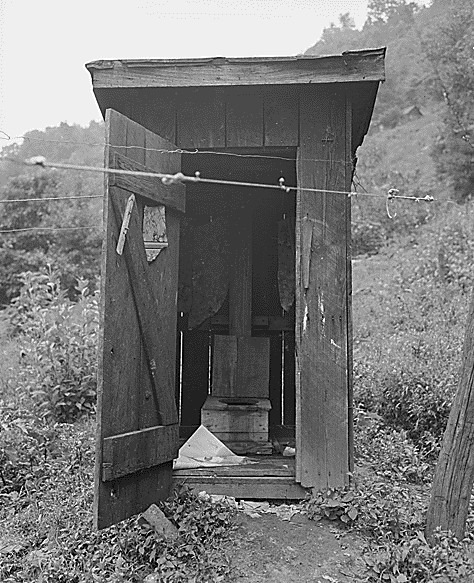
coal companies provided pit privies for use by miners when above ground
Source: National Archives, Typical privy. Raven Red Ash Coal Company, No. 2 Mine, Raven, Tazewell County, Virginia (1946)
Old outhouses were just a shallow pit with a simple wooden house above it. If a pit was dug below the water table, users of an outhouse heard a splash.
Underneath an outhouse in regular use, the liquids seep directly into the soil. Similar to old municipal solid waste dumps, there is no liner. The waste may be out of sight, but all of it may not stay in the pit. For a single household, even one with a large number of children, only a small zone of soil near outhouse will be affected. In karst topography, however, waste fluids may seep through the cracks in the limestone and contaminate any drinking water well nearby. (Modern pit toilets at campgrounds include a watertight vault underneath so waste can be pumped into a truck and hauled away, or are designed as composting toilets.)
At Virginia mansion houses such as Mount Vernon and Monticello, pit toilets were designed so slaves would remove the waste at the bottom. In less-fancy houses, if a pit filled up faster than the waste decomposed, a new pit could be dug and the outhouse moved. No complex piping or heavy construction equipment was needed to abandon one location and move to another.
Archeologists find old privy sites to be rich treasure troves of historic artifacts (broken ceramics and bottles, useful for establish dates when a building was occupied) that were tossed down the hole. The ancient human waste dries out to become "coprolite," with a texture similar to peat moss and with no smell.2
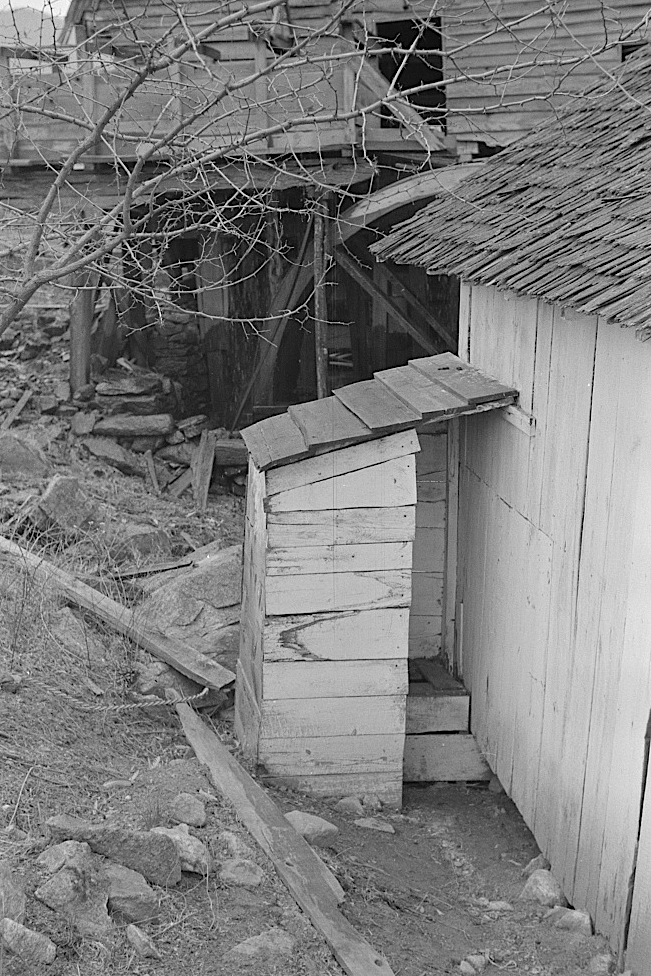
outdoor privies were "necessaries," and rarely designed to be attractive places
Source: Library of Congress, Privies near old sawmill on road to Skyline Drive, Virginia (by Lee Russell, 1938)
Decomposing human waste piling up underneath an outhouse may generate unpleasant odors, even if lime is thrown into the pit. In rare circumstances, however, that can make a pit toilet an attractive location.
When Col. John Mosby raided the town of Fairfax on March 9, 1863 during the Civil War, Lieutenant Colonel Robert Johnstone of the 5th New York evaded capture by hiding in the outhouse. Today that location is the Bailiwick Inn bed-and-breakfast, across the street from the historic Fairfax County courthouse.
The Confederate raiders captured Union Army General Stoughton in bed but Lieutenant Colonel Johnstone fled out of his bedroom. As described in Mosby's memoirs, Johnstone "hid in the garden."
According to local tradition, however, the colonel hid underneath the bench in the outhouse. Not surprisingly, Mosby's raiders failed to look down the hole in an outhouse to find the Yankee officer. (At last report, no Civil War history buff has re-enacted that particular drama.)3
Outhouses may be simple structures, but they still require basic maintenance. In August, 2000, an elderly gentleman in Carroll County fell into the pit underneath his outhouse, after the floorboards collapsed. He was unable to climb out. It took a couple of days before his rural mail carrier noticed the mail had not been picked up. He stopped to check, and heard a quiet call for help. Together with a neighbor, the mail carrier was able to rescue the elderly homeowner, though it required climbing into the pit.
The homeowner who fell into the outhouse finally agreed that he wanted indoor plumbing. Carroll County requires that a house meet the building code standards before issuing building permits for major improvements, however, and his home was in no better shape than his outhouse. Rural housing advocates and Virginia Tech students arranged for a new home with indoor plumbing, to replace both old structures.4
A traditional outhouse was a hole in the ground in which biological processes decomposed human waste:5
Decomposition of the human waste attracted flies and created unpleasant smells. Outhouses were located far enough from the main house that the flies/smells would not be a problem, except when the privy was in use. If too much human waste accumulated underneath the wooden seat in the privy, a new hole could be dug rather than shovel out the smelly material. The shell of the privy would be moved over top of the new hole, while the old hole was covered with dirt.6
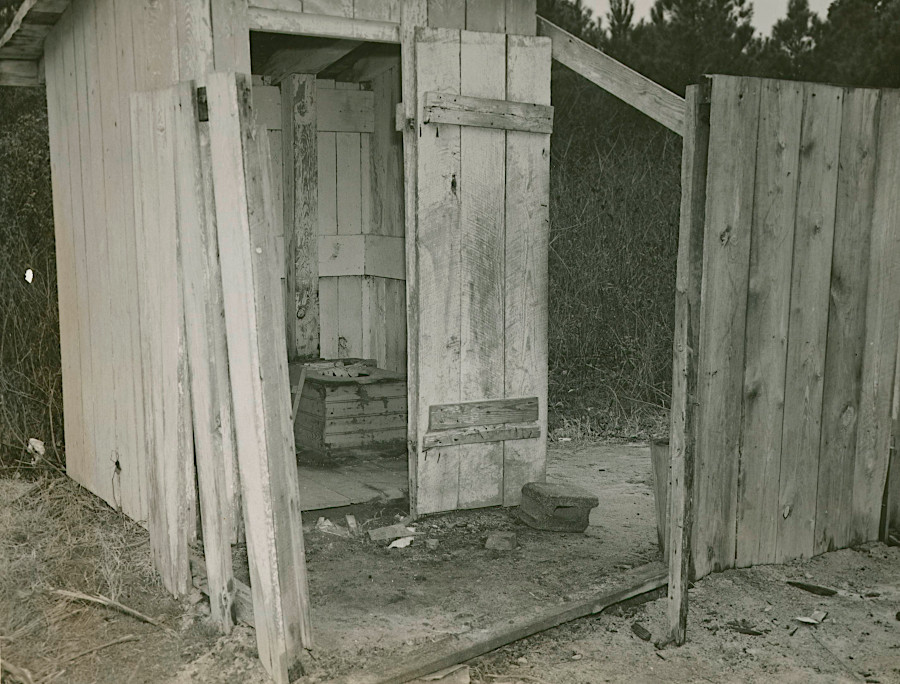
during Jim Crow segregation, restroom facilities at non-white schools were both separate and unequal
Source: National Archives, View of the Boy's Bathroom at Gloucester Training School (1948)
The distance from the main house made use of the outhouse a challenge at night. Chamber pots were used indoors to avoid making a journey in the dark to the outhouse. Chairs were modified so the seat could be lifted up, exposing a chamber pot underneath and allowing the user to defecate while sitting down.
Emptying chamber pots was a chore completed in daylight when the contents could be flung into the woods or dumped in a standard spot at the edge of a field. In some places, "night soil" may have been used in a garden as a fertilizer. In towns, chamber pots were often emptied onto the dirt street near the house. It is likely that enslaved workers tasked with emptying chamber pots were told to carry the waste some distance away from the front door.
In many colonial Virginia homes, no privy was ever constructed; chamber pots alone were sufficient. No sign of a privy has been identified near George Washington's boyhood home at Ferry Farm.
At Mount Vernon, Washington had four "necessaries" constructed around the garden. The two that have been rebuilt for observation by tourists today have three seats each. The privy at William Byrd II's Westover Plantation had five holes, with no divider between them. Privacy standards may have been different in the 1700's. It is also possible that only one person at a time used the facility, and different members of the family had their own designated hole.
Washington recognized that his enslaved workers need a toilet. In 1796, while finishing his second term as President, he wrote from Philadelphia to his farm manager in Virginia: 7
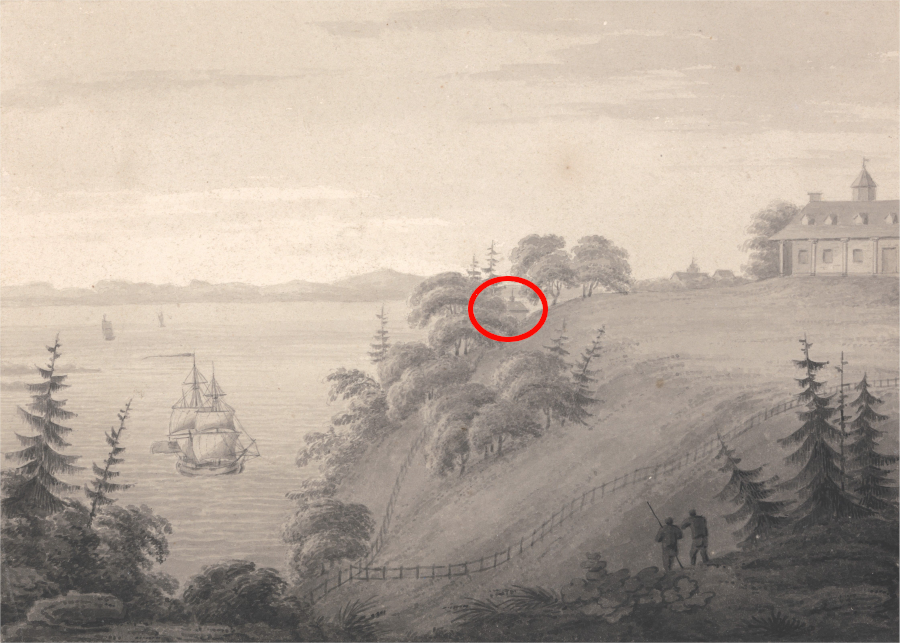
George Washington ordered relocation of the privy on the "brow of the Hill" at Mount Vernon
Source: Yale Center for British Art, Paul Mellon Collection, View of Mount Vernon, the seat of General Washington (by Isaac Weld, 1795)
Building a traditional outhouse where waste decomposes in the ground without any treatment is no longer legal in Virginia. Modern versions of the pit toilet can process the waste through aerobic decomposition by composting in facilities certified by the National Sanitation Foundation. The organic material removed from a composting toilet may not be placed in a vegetable gardens or on the ground surface. The National Sanitation Foundation also certifies incinerator toilets, which convert human waste into ash.
The Clivus Multrum ("inclined chamber") composting toilet was invented in 1939. Inside a waterproof vault underneath the toilet, bacteria, fungi, insects and compost worms decompose human waste in an aerobic environment into stable organic matter.
To avoid anaerobic decomposition, urine and other fluids move down the inclined plane so most material is not water-saturated. Bacteria convert urea (H2NCONH2) in the liquid waste into nitrite (NO2-) and nitrate (NO3-) ions rather than ammonia (NH3, hydrogen sulfide (H2S), and methane (CH4). Aerobic decomposition minimizes smells associated with typical pit toilets, in which waste accumulates in a pile beneath a toilet seat and oxygen is excluded from most of the pile.
Carbon dioxide (CO2) and water vapor are vented to the exterior; solids are removed after one or more years. Feces are reduced in volume by 90% through the decomposition process. In the long aerobic decomposition process, human pathogens are eliminated from the organic-rich solids.
A Clivus Multrum composting toilet does not need to be connected to a sewer pipe, but the decomposition process requires temperatures around 65-113°F. In Virginia, they are not suitable for unheated outdoor facilities on trails and in parks without access to electricity.
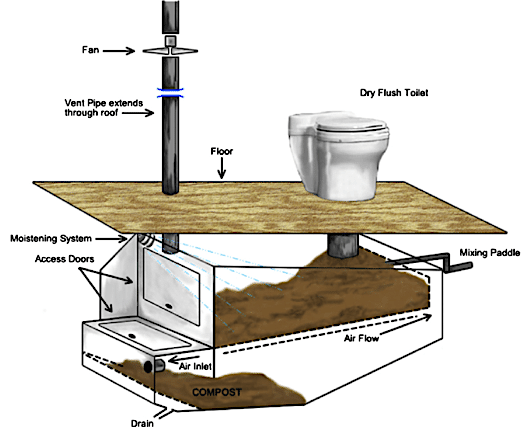
some types of composting toilets require heated spaces and electricity
Source: Waste Management, Composting toilets as a sustainable alternative to urban sanitation - A review
Composting bin outhouses are designed for use in isolated locations. Bark is brought to the outhouse and mixed with nitrogen-rich waste. Moldering privies operate on similar principles, but rely upon lighter wood shavings which are easier to backpack to locations furthest from roads. Bacteria processing waste need a balance between the carbon in the wood products and the nitrogen in the waste. Without enough carbon, the urea and ammonia will generate unpleasant smells.
Backcountry hikers are asked to toss wood chips into composting toilets, to add carbon along with the nitrogen-rich waste they deposit. Users of composting bin outhouses are asked to pee in the woods, in order to limit the nitrogen input and thus the amount of carbon-rich bark which must be transported. Users of moldering privies are encouraged to pee in the toilet so there will be adequate moisture for the decay process.8
The most common outhouses today are portable units designed to store waste for future removal. Porta-potties are used at construction sites to capture the waste underneath in a watertight vault, rather than allow liquids to seep into the soil.
Porta-potty vaults are containment vessels, and are not designed for bacterial processing. Such toilets are cost-effective at locations where use will be just temporary or demand will peak briefly, such as sites of fairs and concerts. State law requires one privy to be provided for each 100 people expected to attend an event, and one privy for each 25 people at a construction site.9
Airplanes, boats and recreational vehicles, and some rural parks have vault toilets as well. In the simplest version, there is a direct drop from a toilet seat to a vault below. Waste accumulates - and odors increase - until the vault is emptied.
In some recreational vehicles, the blackwater from toilets is captured in one tank and the greywater from sinks/showers is captured in a separate tank. Both tanks are emptied at dump stations, and greywater may be used to rinse out the blackwater tank and sewer hose.
Recreation sites, from vista overlooks at national parks to county ballfields, attract crowds of people to locations that may be far from sewer lines. The waste from restrooms in these sites is collected in vaults, then pumped occasionally into the same "honey wagon" trucks that are used to empty tanks of septic systems. The trucks haul the sewage to wastewater treatment plants, serving essentially as portable sewer lines to link the sites where waste is collected to the site where waste is processed.
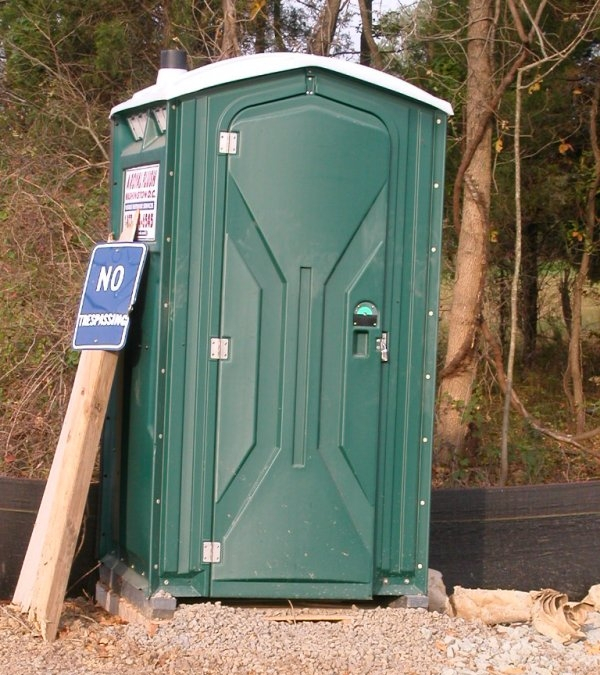
where does waste from a portable toilet end up?
Staff responsible for pumping the waste from the vault to the trucks do not appreciate it when people throw soda cans or other "recycle or throw in a trash can" garbage down the pit toilets. Large items that do not decompose in the vault can clog the hoses used to pump out the tanks, and will need to be pulled out of the vault by tongs or even by hand.
Initial construction costs may be minimized by a decision to use pump-and-haul facilities rather than extending sewer pipes, but annual operating costs are increased. Some communities, such as Prince William County, have made exceptions to their normal standards on when sewer services may be extended outside the intended service area. Sewer pipe extensions may be authorized to service public facilities - such as county parks - in areas where private properties will not be offered sewer service, in order to minimize long-term operational costs for the county.
In airplanes and other facilities with fancier pit toilets, a circulating fluid may be used to carry human waste into a holding tank, similar to flush toilets in modern houses. In the 1980's the blue liquid was formaldehyde with a heavy perfume added to mask the odor and slow decomposition, until some lucky soul got to pump out the tanks and haul the waste to a treatment facility. Today, less-hazardous chemicals are used for sanitizing fluids, and airplanes have implemented vacuum-assisted toilet systems to reduce the weight of the fluids in the system.
At some sites in natural areas, composting toilets have become the high-tech version of the outhouse. Aerobic bacteria and fungi break down the waste, converting it to compost without requiring water or electricity. Maintaining the correct balance between nitrogen and carbon, and ensuring sufficient ventilation, may require regular maintenance visits and the occasional introduction of wood chips/peat moss. After the microorganisms complete their digestion, urine, excrement, toilet paper in a composting toilet will decompose to 10-30% of the original volume. The remaining "humus" is hauled away to final processing at a wastewater facility.
Amish residents in Richmond County have successfully pressured local officials to authorize vault toilets there. In 2022 the Board of Supervisors reversed a ban it had imposed two years earlier. The Amish wanted to use vault toilets near their schools to maintain their traditional culture.10
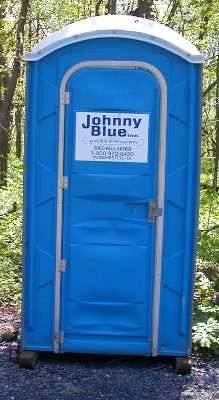
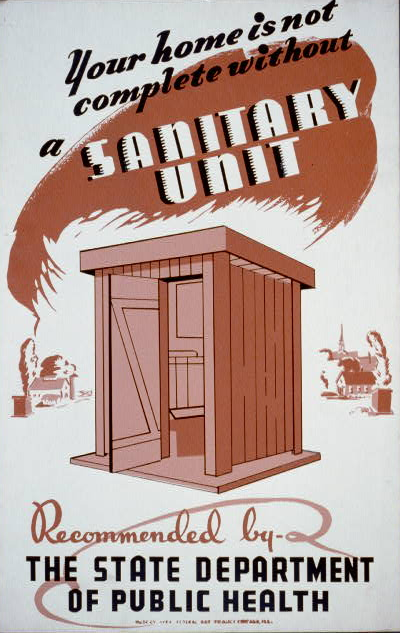
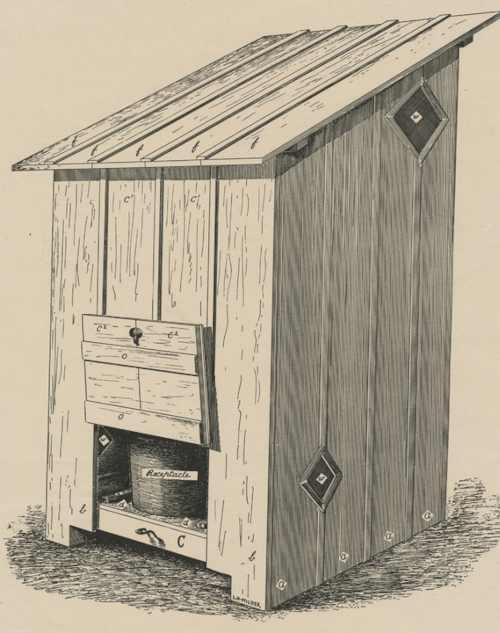
"outdoor" plumbing was common, except in urban areas, until after World War II
Source: Library of Congress, Your home is not complete without a sanitary unit (WPA Federal Art Project, between 1936 and 1941) and US Department of Agriculture, Sanitary privy design (1910)